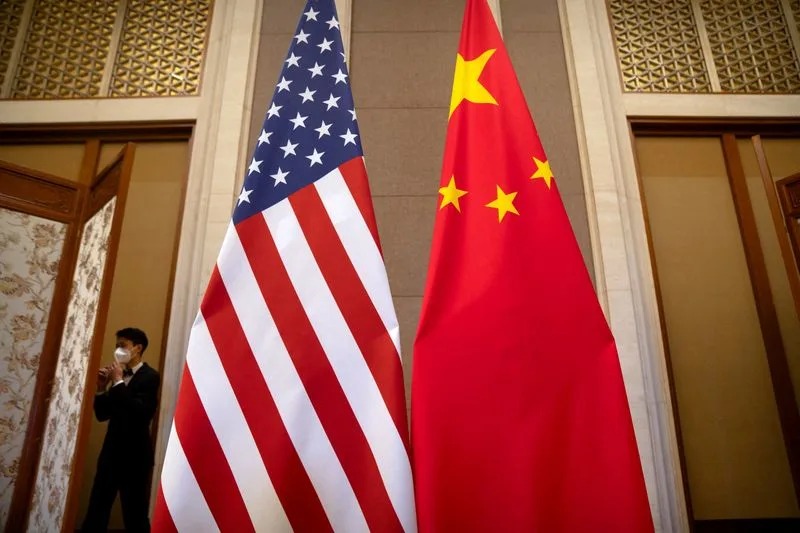Yield gap between China and US widens to highest since 2007 after surprise rate cut

Image: Collected
Yield differentials between China and the United States widened to their highest 16 years on Wednesday, as investors speculated that China's central bank would ease monetary policy further after a surprise rate cut, even if it puts the yuan under pressure.
The People's Bank of China (PBOC) unexpectedly cut key policy rates for the second time in three months on Tuesday, in a fresh sign that the authorities are ramping up monetary easing efforts to boost a sputtering economic recovery. And markets widely expect the PBOC to loosen monetary policy further.
Earlier in the session, the PBOC also ramped up liquidity injection by offering the most short-term cash through seven-day reverse repos in open market operations since February. [CN/MMT]
China remains an outlier among global central banks as it has loosened monetary policy to shore up a stalling recovery whereas others, particularly the United States, have been in tightening cycles as they battle high inflation. But the divergent monetary policy paths between the world's two largest economies widened the yield gap to 164 basis points between China's benchmark 10-year government bonds and U.S Treasuries s - the highest since February 2007.
"The significant yield gap, the largest since 2007, could be a key reason why capital remains planted in US dollars and US Treasuries for the time being," said David Chao, global market strategist at Asia Pacific at Invesco.
"More broadly, recent economic data releases in China have been disappointing, while those in the U.S. have surprised to the upside."
The widening yield gap reduced foreign appetite in China's onshore yuan bonds, with latest official data showing overseas investors' holding declined in July.
Tumbling credit growth and rising deflation risks in July warranted more monetary easing measures to arrest the slowdown, market watchers said, while default risks at some major property developers and missed payments by a private wealth manager also hurt confidence in China's financial markets.
In derivatives market, one-year interest rate swaps, a gauge that measures investor expectations of future funding costs, fell to 1.84% this week, the lowest since September 2022, suggesting some market participants are pricing in further rate reductions.
But the expectations for further monetary easing and capital outflow risks has pressure on the Chinese yuan to depreciate further. The yuan has lost about 5.5% against the dollar since the start of the year, making it one of the worst performing Asian currencies.
"The PBOC will need to do more to manage the pace of yuan depreciation," Eugenia Victorino, head of Asia strategy at SEB, said in a note.
The People's Bank of China (PBOC) unexpectedly cut key policy rates for the second time in three months on Tuesday, in a fresh sign that the authorities are ramping up monetary easing efforts to boost a sputtering economic recovery. And markets widely expect the PBOC to loosen monetary policy further.
Earlier in the session, the PBOC also ramped up liquidity injection by offering the most short-term cash through seven-day reverse repos in open market operations since February. [CN/MMT]
China remains an outlier among global central banks as it has loosened monetary policy to shore up a stalling recovery whereas others, particularly the United States, have been in tightening cycles as they battle high inflation. But the divergent monetary policy paths between the world's two largest economies widened the yield gap to 164 basis points between China's benchmark 10-year government bonds and U.S Treasuries s - the highest since February 2007.
"The significant yield gap, the largest since 2007, could be a key reason why capital remains planted in US dollars and US Treasuries for the time being," said David Chao, global market strategist at Asia Pacific at Invesco.
"More broadly, recent economic data releases in China have been disappointing, while those in the U.S. have surprised to the upside."
The widening yield gap reduced foreign appetite in China's onshore yuan bonds, with latest official data showing overseas investors' holding declined in July.
Tumbling credit growth and rising deflation risks in July warranted more monetary easing measures to arrest the slowdown, market watchers said, while default risks at some major property developers and missed payments by a private wealth manager also hurt confidence in China's financial markets.
In derivatives market, one-year interest rate swaps, a gauge that measures investor expectations of future funding costs, fell to 1.84% this week, the lowest since September 2022, suggesting some market participants are pricing in further rate reductions.
But the expectations for further monetary easing and capital outflow risks has pressure on the Chinese yuan to depreciate further. The yuan has lost about 5.5% against the dollar since the start of the year, making it one of the worst performing Asian currencies.
"The PBOC will need to do more to manage the pace of yuan depreciation," Eugenia Victorino, head of Asia strategy at SEB, said in a note.
Source: https://finance.yahoo.com
Previous Story
- Oil falls as firm dollar, China economy counter...
- Tesla Cuts China Prices Again, Triggering Slump in...
- Prices in China are Falling: Here's Why That's...
- Siemens CEO says customers looking outside China for...
- China's economy is sputtering as the nation's exports...
- China EV brand Zeekr to launch its first...
- Yuan loses core support as firms leave China
- Scramble to Validate Superconductor Breakthrough Confirms Zero Resistance,...